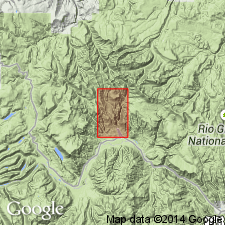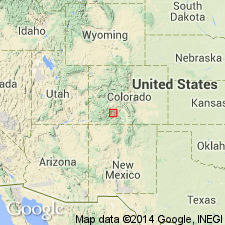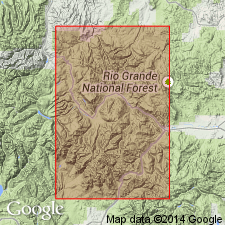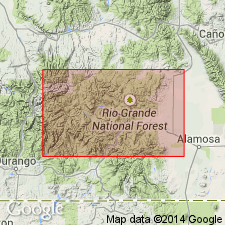
- Usage in publication:
-
- Campbell Mountain rhyolite*
- Modifications:
-
- Original reference
- Dominant lithology:
-
- Rhyolite
- AAPG geologic province:
-
- San Juan Mountains province
Summary:
Campbell Mountain rhyolite of Alboroto group of Potosi volcanic series. Overlying the Willow Creek rhyolite rather irregularly is a rhyolite flow breccia here named Campbell Mountain rhyolite. In most places no evidence was seen of more than one flow, but on East Willow Creek two flows of this type are separated by a few hundred feet of Phoenix Park quartz latite. Thickness 0 to 1,000 feet. Upper contact of Campbell Mountain rhyolite is everywhere sharp, but some of overlying rocks so closely resemble it that separation was somewhat difficult. Age is Miocene.
Named from Campbell Mountain, Creede district, [San Luis Peak 7.5-min quadrangle], Mineral Co., southwestern CO.
Source: US geologic names lexicon (USGS Bull. 896, p. 325).

- Usage in publication:
-
- Campbell Mountain Member*
- Modifications:
-
- Revised
- AAPG geologic province:
-
- San Juan Mountains province
Summary:
Campbell Mountain Member of Bachelor Mountain Rhyolite. In the San Juan Mountain province, Campbell Mountain Rhyolite of Emmons and Larsen (1923) is reduced in stratigraphic rank and assigned to the Bachelor Mountain Rhyolite as its middle member. Age is middle or late Tertiary.
Source: Modified from GNU records (USGS DDS-6; Denver GNULEX).

- Usage in publication:
-
- Campbell Mountain Bed*
- Modifications:
-
- Revised
- Age modified
- AAPG geologic province:
-
- San Juan Mountains province
Summary:
Pg. A8-A9, A79. Campbell Mountain Bed of Bachelor Mountain Member of Carpenter Ridge Tuff. Reduced in stratigraphic rank from Campbell Mountain Member of Bachelor Mountain Tuff to Campbell Mountain Bed, middle bed of Bachelor Mountain Member (revised) of Carpenter Ridge Tuff (revised). Overlies Willow Creek Bed (revised) of Bachelor Mountain; underlies Windy Gulch Bed (revised) of Bachelor Mountain. Age is changed from Oligocene --to-- late Oligocene.
Source: Publication.

- Usage in publication:
-
- Campbell Mountain zone*
- Modifications:
-
- Revised
- AAPG geologic province:
-
- San Juan Mountains province
Summary:
Revised to informal status and is referred to as middle of three zones within Bachelor Mountain Member of Carpenter Ridge Tuff. Restudy of Creede area, Mineral Co, CO, San Juan Mountain province, has shown that within central part of Bachelor caldera in San Juan volcanic field, unit represents middle zone of upward sequence of progressively less welded zones within thick rhyolitic caldera fill. At margins of caldera welding zones, alternate and interfinger complexly. Unit previously thought to be a discrete eruptive deposit. Grades downward into Willow Creek zone (revised to informal status) of Bachelor Mountain; grades upward into Windy Gulch zone (revised to informal status) of Bachelor Mountain. Oligocene age (27.35 Ma).
Source: GNU records (USGS DDS-6; Denver GNULEX).
For more information, please contact Nancy Stamm, Geologic Names Committee Secretary.
Asterisk (*) indicates published by U.S. Geological Survey authors.
"No current usage" (†) implies that a name has been abandoned or has fallen into disuse. Former usage and, if known, replacement name given in parentheses ( ).
Slash (/) indicates name conflicts with nomenclatural guidelines (CSN, 1933; ACSN, 1961, 1970; NACSN, 1983, 2005, 2021). May be explained within brackets ([ ]).

